We have a strict honest review policy, but please note that when you buy through our links, we may receive a commission. This is at no extra cost to you.
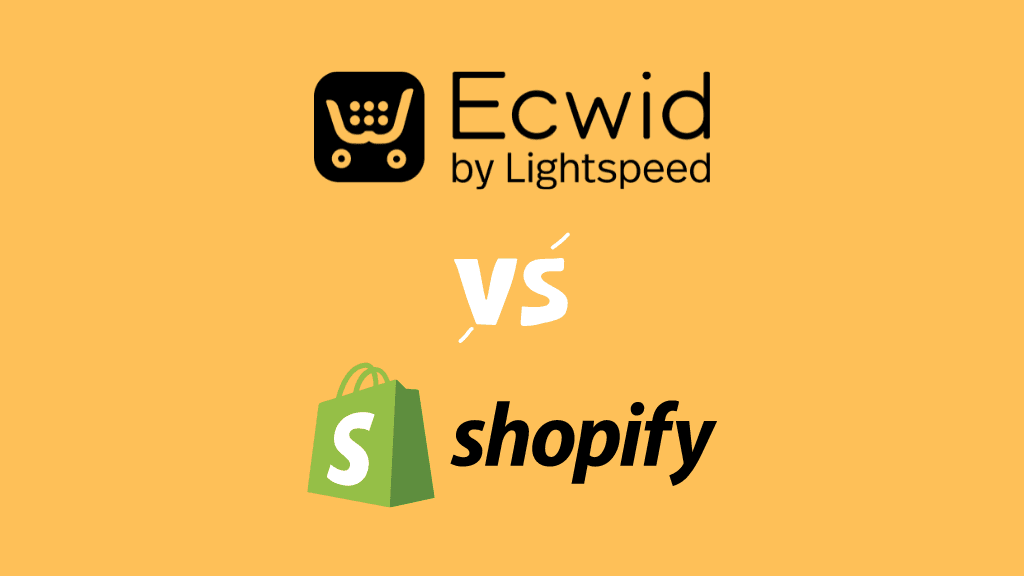
In this Ecwid vs Shopify comparison I pit two popular — but really quite different — ecommerce apps against each other. Which one comes out on top?
First up you’ll find my quick verdict, which is then followed by my deep dive into both tools.
Quick verdict
If you already have an online presence that you want to add ecommerce to, Ecwid is usually the more obvious choice. It is significantly better than Shopify when it comes to adding comprehensive selling capabilities to an existing website (and more flexible when it comes to product options too).
But if you’re building an ecommerce site from scratch, I’d recommend Shopify. Although Ecwid, thanks to its ‘Instant Site’ feature, does now provide you with a way to build a standalone store, the functionality provided by it is not nearly as comprehensive as what you’ll get from Shopify. This is particularly the case if you have any point of sale, dropshipping or print-on-demand requirements — you’ll get more professional results on all counts from Shopify.
| Reasons to use Ecwid | Reasons to use Shopify |
|---|---|
| Turns any website into fully-featured online store | Much better for creating standalone stores |
| No charges for using third-party payment gateways | Lets you sell an unlimited number of products |
| No limits on product options | Much better point-of-sale features |
| Selling digital files is easier | Much stronger multi-currency selling tools |
| Built-in GPDR tools | More dropshipping and print-on-demand options |
How to get started with Ecwid and Shopify
I’ll start my full comparison with a quick overview of both platforms.
Ecwid and Shopify: a quick overview
On first inspection, Ecwid and Shopify look quite similar: they are both browser-based store builders that let users without any coding knowledge create an online store, upload products to it and manage inventory.
They’ve got quite different backgrounds and history, however.
Shopify was initially conceived as a tool that allowed users to create a brand new, standalone online store — i.e., a fully-functional website on a domain of their choosing — while Ecwid was designed to let people sell products on an existing site by adding a snippet of code to it.
(Hence the name ‘Ecwid’ — ‘ecommerce widget’).
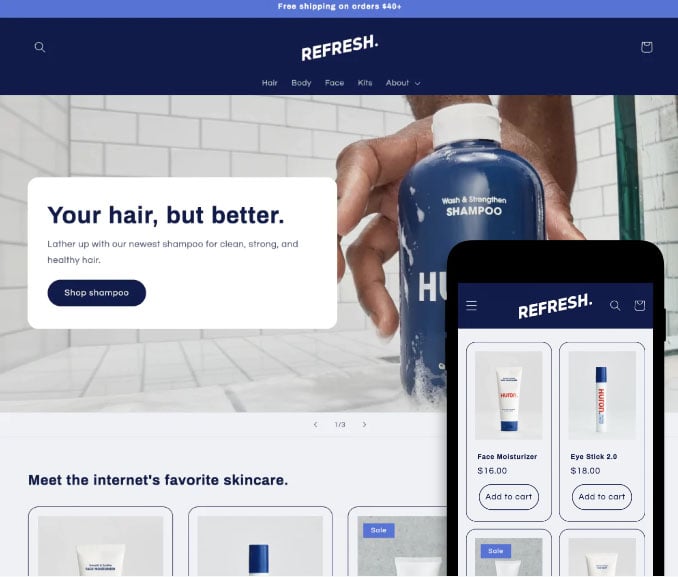
In recent years however, the differences between them have become less pronounced. You can now embed a Shopify product catalog on an existing site — and use Ecwid to build a standalone online store. But as I’ll explain shortly, they don’t do this equally well.
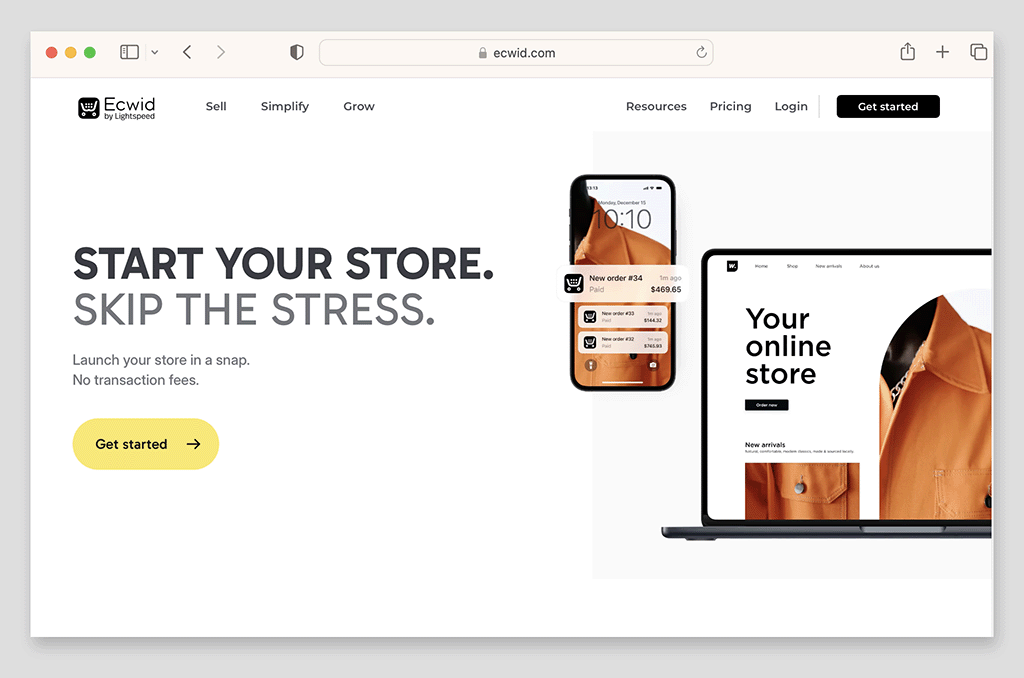
Of the two products, Shopify is the older site builder — it was created in 2006 — and it has a bigger userbase. At time of writing (August 2025), Internet stats company Builtwith.com estimates that around 5.8 million websites are currently powered by the platform.
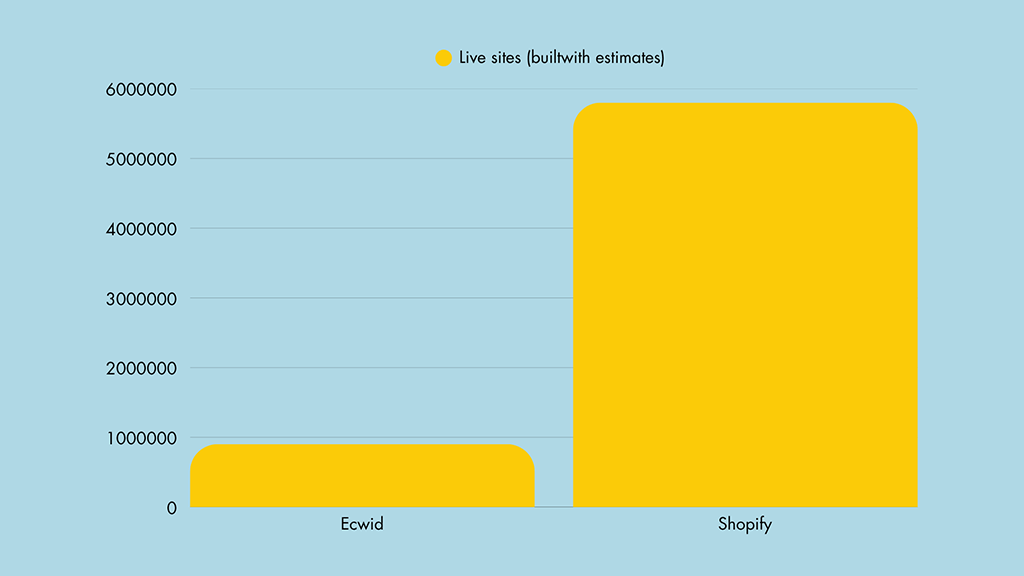
Ecwid was launched in 2009, with Builtwith.com estimating that it now powers over 902,000 sites. In 2021, it was acquired by the point-of-sale solution company Lightspeed.
So that’s a bit of background of Ecwid and Shopify — now what about their prices?
Pricing
Ecwid pricing
Ecwid offers you four plans.
The USD prices for these are as follows:
- Starter — $5 per month
- Venture — $30 per month
- Business — $55 per month
- Unlimited — $130 per month
(Paying on an annual basis reduces your fees by about 16%.)
Ecwid pricing in other countries varies, however. In a lot of territories, Ecwid costs considerably more than in the USA. For example, Ecwid’s UK plans cost roughly 32% more than their US counterparts.
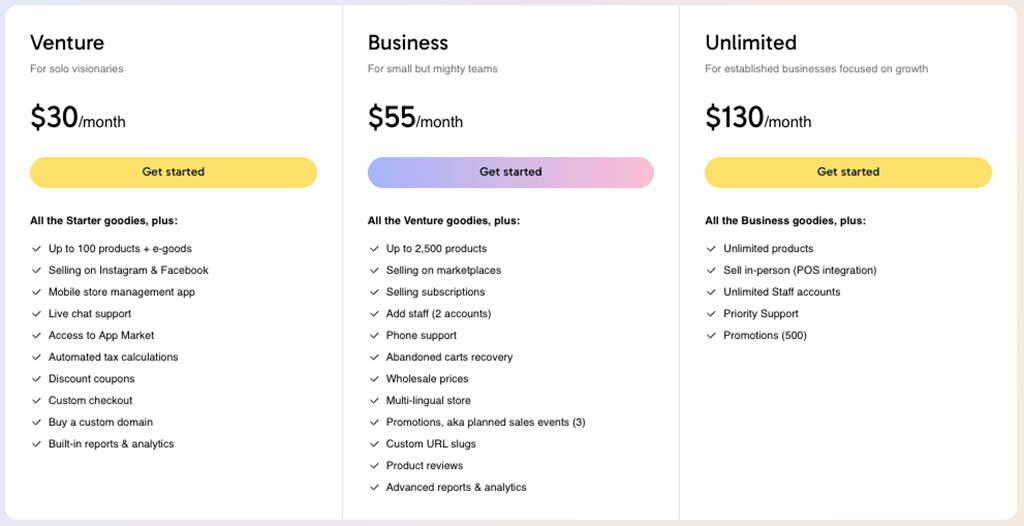
Oddly there’s currently no free trial available for Ecwid — this contrasts negatively with Shopify, which gives you a 3-day free trial or a 3-month for $1/mo trial.
The most obvious difference between the Ecwid plans involves product limits — these increase in size as you go up the pricing ladder.
You are limited to 5 products on the ‘Starter’ plan; this rises to 100 on ‘Venture’, 2,500 on ‘Business’ and, as the name suggests, an unlimited number on the ‘Unlimited’ plan.
And it’s important to note that you can’t use Ecwid’s Starter plan to sell on social channels (like Facebook or Instagram). This contrasts negatively with Shopify’s similarly priced (and similarly named!) ‘Starter’ plan, which does let you do that.
The Ecwid feature set becomes more extensive as you pay more — accessing features like abandoned cart saving, gift cards, point of sale features and more comprehensive support depends on the plan you’re on.
With all Ecwid plans, you can either embed your products on another site or create a basic standalone site, using Ecwid’s ‘Instant Site’ feature.
Note: if you’re a Wix user, you can start selling with Ecwid at a lower price — you can find out more about Wix and Ecwid pricing here.
Shopify pricing
Shopify provides five pricing plans:
- Starter — $5 per month
- Basic — $39 per month
- Grow — $105 per month
- Advanced — $399 per month
- Shopify Plus — pricing varies depending on requirements, but Shopify Plus fees typically start at $2,300 per month
As with Ecwid, discounts are available for all these if you pay on an annual rather than monthly basis.
All the Shopify plans allow you to sell an unlimited number of goods, using as many categories as you like; they all let you sell at point of sale too (i.e., in physical locations like retail stores, market stalls etc.).
The main differences between the Shopify plans involve:
- credit card fees
- the number of user accounts you can have
- real time carrier shipping features
- the availability of discounts on shipping
- international selling features
- checkout capacity
The more you pay, the more you get on all fronts.
Now, it’s worth dwelling on one key thing that the ‘Shopify Starter’ plan doesn’t let you do: create a fully-customizable standalone online store. The ‘Starter’ plan is — like Ecwid — more about selling your products elsewhere.
It allows you to:
- display your products (but not other types of content) on a simple storefront
- sell on Facebook and other social media channels
- sell at point of sale
- sell on messaging apps (WhatsApp, Messenger etc.)
- make use of a Shopify ‘Buy Button’ that allows you to embed and sell products on an existing site.
This is all pretty useful functionality — but if you need a standalone online store, it’s best to start off with a ‘Basic’ or higher plan.
As mentioned earlier — and unlike Ecwid — Shopify lets you access a free trial.
The trial itself is very short — just 3 days — but Shopify is currently testing a new system that lets you make use of the platform for an additional three months for just $1 per month. This means that you can get full access to Shopify for over 90 days at virtually no cost. This offer — which is likely to be available for a limited time only — can be accessed here.
A quick note about the ‘Shopify Plus’ plan: this is designed with ‘enterprise’ users in mind — i.e., those with very particular needs regarding security and uptime, a desire to sell in multiple POS locations, or advanced requirements when it comes to integrating Shopify with internal systems (CRM tools, databases etc.).
For most businesses however, one of the cheaper Shopify plans works fine.
Pricing, of course, is just one part of the picture — and not necessarily the most important part! So, let’s drill down into the specific ecommerce features you get with Ecwid and Shopify.
Ecommerce features
Both Ecwid and Shopify provide the basic features and functionality that you’d expect from an online store builder.
They both give you the ability to:
- sell physical and digital products
- accept a wide range of payment types
- manage inventory
- facilitate point-of-sale ecommerce
- define shipping rates and rules
However, there are some important differences between both platforms’ approaches to all the above that need to be flagged up.
Let’s explore these.
Payment gateways and transaction fees
A payment gateway is the software that processes your customer’s transactions securely. There are lots of companies that offer payment gateway services — well-known ones include Paypal, Stripe and Worldpay.
Ecwid and Shopify work with a very wide range of payment gateways — when setting up test stores for both platforms, I was able to connect up to 58 gateways to Ecwid and 105 to Shopify.
Additionally, Shopify offers its own payment processing option, ‘Shopify Payments.’ This is extremely easy to set up and using it means that there are no transaction fees to worry about (so long as you’re on a ‘Basic’ plan or higher — 5% transaction fees apply to the ‘Starter’ plan regardless of whether you’re using Shopify Payments or another payment gateway).
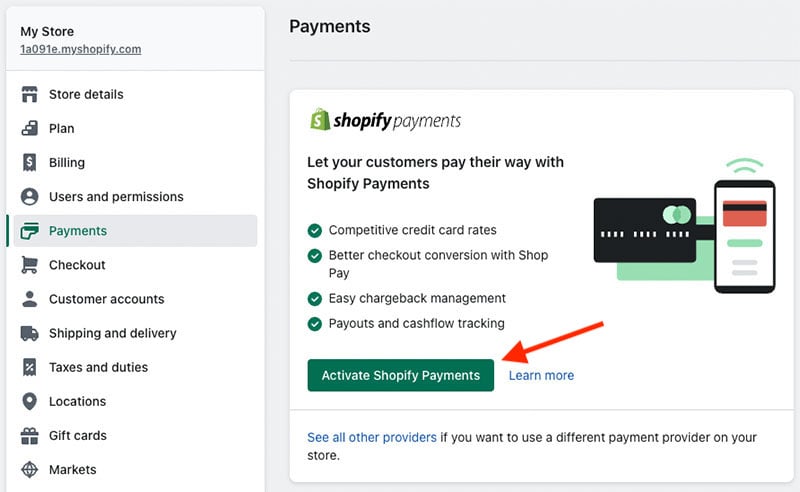
(You will still need to factor in the usual credit card processing fees — but Shopify won’t take a cut of your sales).
However, Shopify Payments can only be used if you are selling from certain countries — these include many EU countries, major English-speaking markets, Switzerland, Hong Kong and Japan.
If your country isn’t supported by Shopify Payments, you will have to use a third-party payment gateway, and you will be charged a percentage of sales for doing so (varying from 0.2% to 2% depending on the plan you’re on). This will be on top of any fees charged by your chosen payment gateway provider.
With Ecwid, you must use a third-party payment gateway to process transactions. On the plus side, you won’t be charged for doing so — but on the down side, you will have to factor in a little bit of time to configure your chosen payment processor.
Tip: Ecwid users based in the US, UK, Australia, Canada, Netherlands, Ireland and Belgium can now make use of ‘Lightspeed Payments,’ a new payment processing option created by the owners of Ecwid.
This is very easy to enable and may in time become a ‘baked in’ payment gateway that is similar in nature to Shopify Payments.
Product limits
Shopify is considerably more generous than Ecwid when it comes to the number of products you can list on your store — it lets you sell an unlimited number of items, regardless of the plan you’re on.
With Ecwid however, restrictions apply. You are limited to selling five products on its ‘Starter’ plan; 100 on its $30 per month ‘Venture’ plan; and 2,500 on its $55 per month ‘Business’ plan.
Only the $130 per month ‘Unlimited’ plan — as its name suggests — lets you upload an unlimited number of products.
Product options
With Shopify, you are limited to using just 3 product options per product.
So, for example, if you were selling a birthday card on Shopify, you could allow users to choose its size, colour and envelope type — but if you wanted to allow them to choose an envelope colour as well, you wouldn’t be able to.
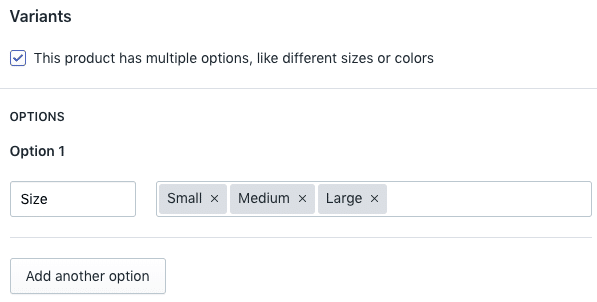
Now, this limit won’t be a showstopper for many merchants — and for those it affects, there are workarounds available. You could buy a Shopify app that removes the limitations; combine two options into one; create separate products; or do some coding to add more options.
I do feel it would be better if Shopify’s product option limits were more generous in the first place, though.
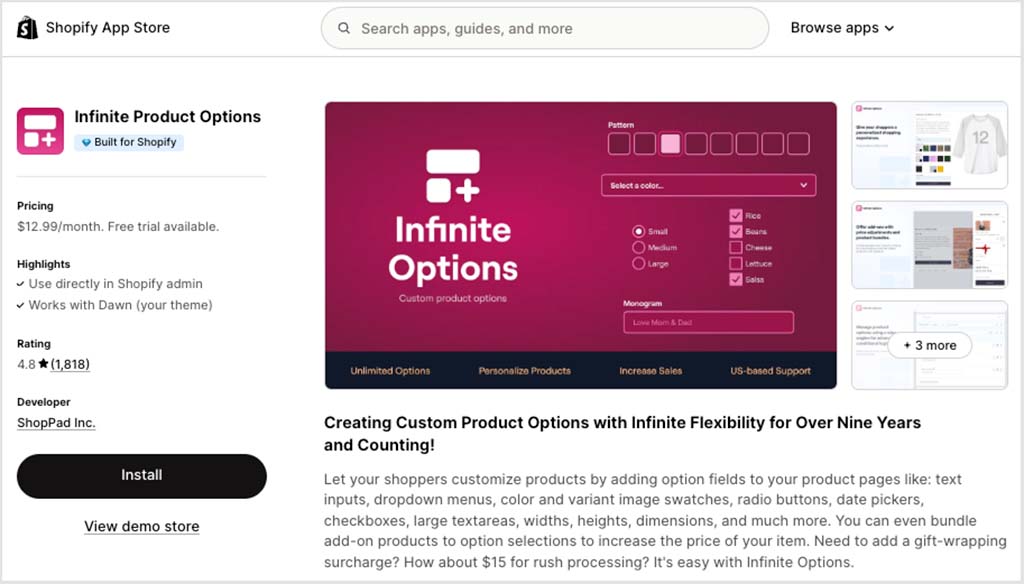
Ecwid, by contrast, is much more straightforward in this regard and doesn’t limit product options at all.
Another issue with Shopify’s product options is that allowing your customers to provide bespoke information for items — for example, some text for an engraving or a gift message — is not possible without either adding some code to a product template, or investing in an app (quite a few are available from Shopify’s app store which give remove the above limitations).
Again, Ecwid works better here — so long as you’re on a paid-for plan, you can just add a simple text box or file upload button to your products to capture any additional information that you might need to fulfil an order.
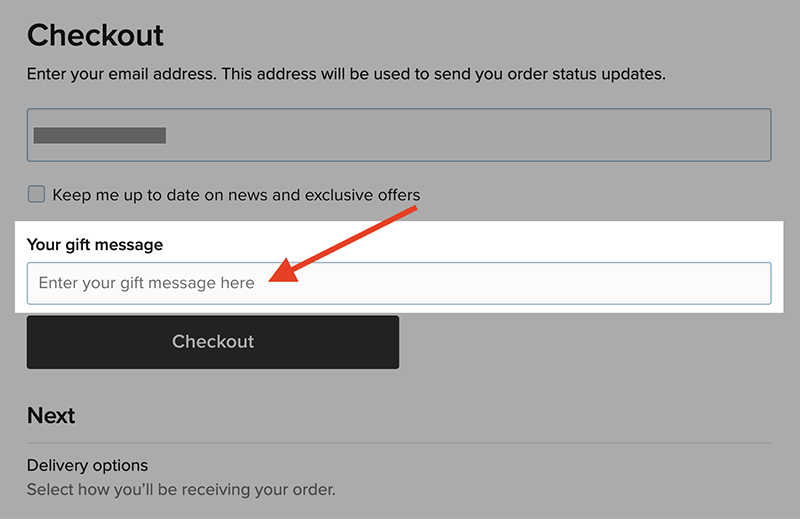
For many merchants, Shopify’s 3 options restriction and its limitations around data capture won’t really pose problems. But for users who have more complex requirements in this area, and want to create a standalone hosted ecommerce site, I’d suggest taking a look at BigCommerce, which is more flexible in this regard.
Overall though in a Shopify vs Ecwid debate, when it comes to ‘out of the box’ flexibility on product options, it’s a win for Ecwid.
But what about product categories?
Product categories
Most online stores are likely to make use of different product catalogs — for example, in a car parts store you might expect to find catalogs containing tyres, exhaust pipes, batteries, headlights and so on.
Setting up catalogs in Shopify and Ecwid is straightforward enough, but Shopify’s approach is, in my view, considerably better — not only can you add products manually to catalogs with Shopify, you can create ones that are automatically populated with products based on conditions you supply.
(The company refers to as ‘smart collections.’)
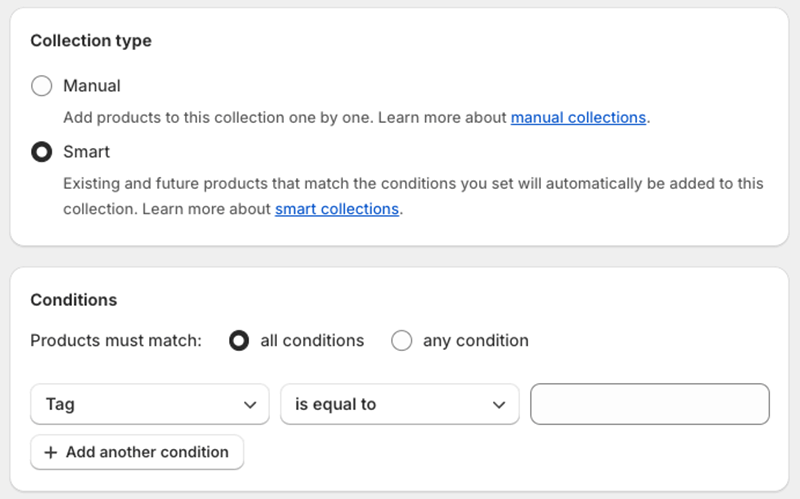
This involves using various criteria to populate a collection — for example, product title, tags, price or weight.
So, using my car parts store example again, to populate an ‘exhausts’ catalog, I could just tell Shopify to automatically add any product with the word ‘exhaust’ in its title to it.
This is really useful functionality to have handy if your store contains a very large number of products — but you will have to remember to use consistent naming conventions for your product titles to make it work.
Although Ecwid does let you use filters to help speed up category assignment — and lets you assign products to multiple categories at once via a ‘bulk editor’ tool — it doesn’t yet provide similar ‘smart collection’ functionality, so the winner here is definitely Shopify.
Something to watch out for: product variants
If you were selling T-shirts in different sizes and colors, a small blue t-shirt would count as one variant; a large red t-shirt would count as another.
You can only use these product variants — i.e., combinations of product options — if you are on one of the more expensive Ecwid plans (the $55 per month ‘Business’ plan or higher).
By contrast you can use product variants (up to 100 of them) on any Shopify plan.
Selling digital goods
Both Ecwid and Shopify allow you to sell digital goods — eBooks, music products, videos and so on. Interestingly, Shopify also lets you sell ‘non-fungible tokens’, which some digital creators might find useful.
Ecwid only lets you sell digital products on its $30 ‘Venture’ plan or higher; Shopify lets you do so on any plan, but doing so involves installing a free ‘Digital Downloads’ app. Although this is not particularly complicated, it would be better if, like Ecwid, Shopify simply let you sell digital goods out of the box.
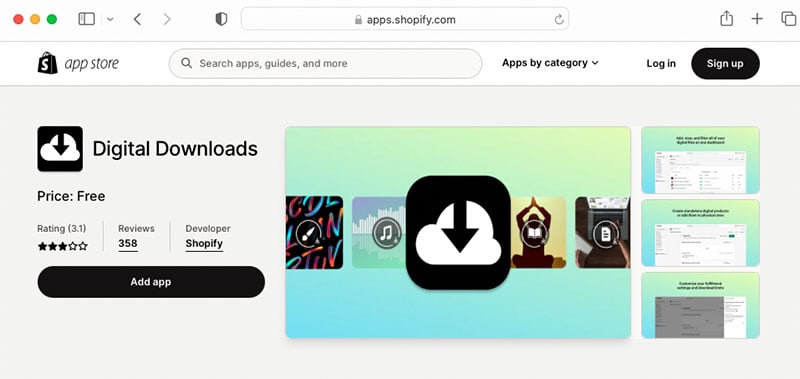
Ecwid is more generous when it comes to the limit it places on file sizes — you can sell files up to 25GB in size, while Shopify’s equivalent limit is 5GB.
You can use third-party apps in conjunction with your Shopify store to increase this limit — but you’ll usually need to pay extra for the privilege.
So, if you have a need to sell large digital files to your customers, it’s a win for Ecwid.
While you’re here, check out our store builder finder tool

Our new store builder finder tool helps you find the right ecommerce platform for your needs. Simply answer a few questions about your requirements and get a personalized recommendation that’s right for you.
Dropshipping in Ecwid vs Shopify
Many users are drawn to ecommerce solutions like Ecwid and Shopify because they want to start a dropshipping business.
Dropshipping is a way of selling goods without manufacturing or stocking anything — you take an order, send it to a supplier and they fulfil the order.
The advantage of this selling model is that you don’t have to invest in lots of stock to set up your online business — instead, your money can go straight into marketing it.

The disadvantage is that dropshipping is very competitive — there are lots of people at this game — and it can be hard to find suppliers of goods that are produced ethically (many of them are made in countries where working conditions can be very poor). The recent introduction of high tariffs on China, where many dropshipped products are sourced from, now makes the business model trickier to succeed with too.
Neither Shopify nor Ecwid facilitate dropshipping ‘out of the box’ but the good news is that it’s still really easy to dropship with both platforms — you just need to add a suitable dropshipping app to your store.
Dropshipping in Shopify is simply a case of adding an app like Spocket or DSers to your store (there are hundreds of others available), picking some goods you’d like to sell and putting your site live. Print on demand is also easy to facilitate with Shopify, thanks to integrations with a wide range of POD apps (including big hitters like Printify or Printful).
Similarly, you can also dropship with Ecwid using apps such as Wholesale2B, Syncee, Spocket or NextsChain.
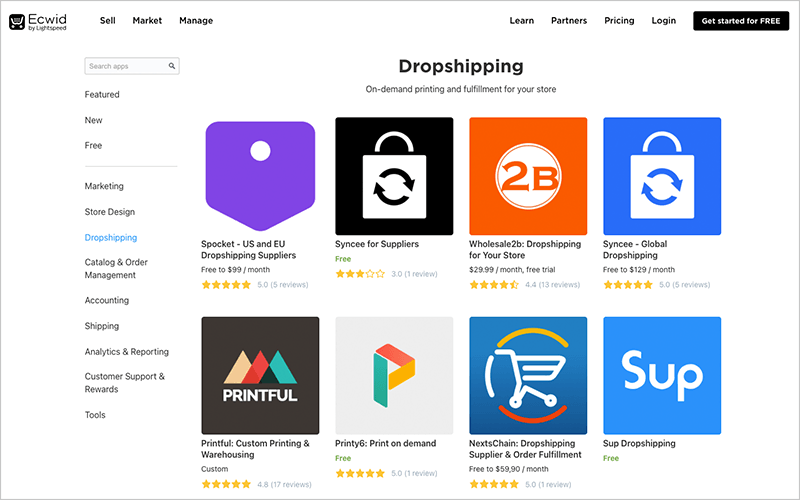
Overall however, there are far more dropshipping options available from Shopify. While Ecwid currently offers its users just 14, I found 701 dropshipping apps in Shopify’s app store.
Similarly, the print on demand options are more limited with Ecwid too — I could only find three POD apps in its app store. On the plus side, one of the leading POD services, Printful, is catered for (you can learn more about this tool in our Printful review). A paid for app lets you connect Printify too.
Don’t miss out — download our free Shopify Startup Kit
Our free Shopify Startup Kit is a must for anyone thinking of building an online store with Shopify. Containing a comprehensive e-book on starting a Shopify store, video tutorials, PDF cheatsheets and much more, it’s packed full of practical advice on how to get a Shopify business off the ground. It’s available for free to Style Factory readers — but for a limited time only.
Point of sale (POS)
Point of sale, or POS, lets you use your online store solution to sell in physical locations like markets, pop-up shops or even retail outlets. Both Shopify and Ecwid come with quite a few POS features, but they work in different ways.
Ecwid POS
With Ecwid, you are encouraged to use Lightspeed Retail POS as your point of sale solution (Lightspeed recently acquired Ecwid, so this isn’t surprising). This is available in a wide range of countries including all the major English-speaking countries — but you can only use it with Ecwid if you’re on a ‘Business’ or ‘Unlimited’ plan.
(You can check out our Lightspeed POS vs Shopify POS comparison here).
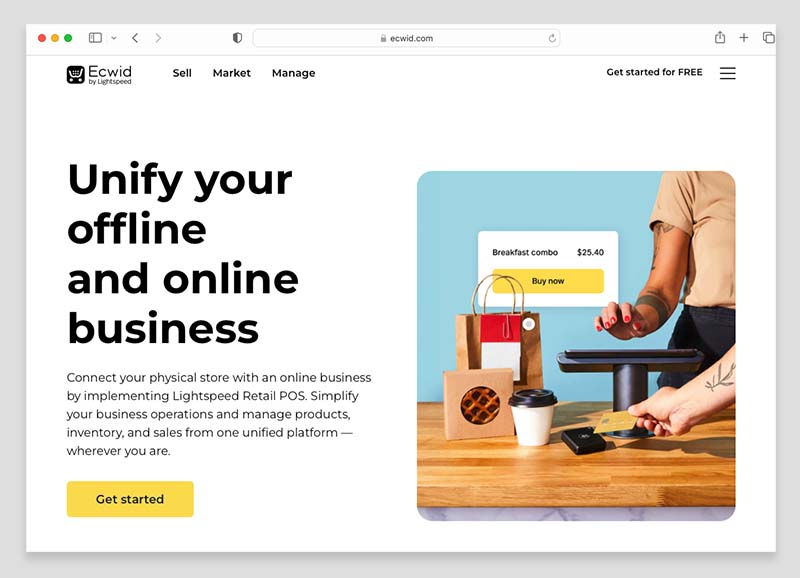
You can also use third-party services in conjunction with Ecwid to gain POS functionality — supported solutions include Square, Clover, Vend and Alice.
(Note that Lightspeed now owns Vend too!).
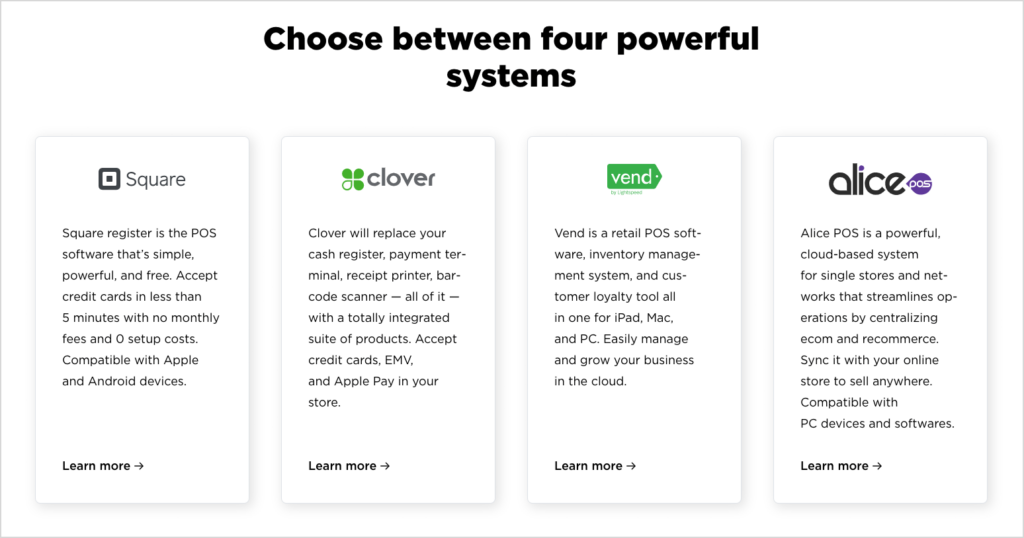
The sort of point of sale hardware that you can use (card readers, barcode scanners and so on) varies by provider and according to which country you’re based in. But if you already use one of those services to take payments in a physical store, you may find Ecwid a nice fit.

The key thing to watch out for is cost. Although most Ecwid plans (‘Venture’ or higher) let you make use of a basic bundled mobile POS system, powered by Square or PayPal Zettle, connecting your Ecwid store to one of the other POS solutions mentioned above will require you to sign up to the most expensive ‘Unlimited’ Ecwid plan.
And the other thing to note about using either Square or PayPal Zettle as your POS option is that the number of countries it works in is limited.
Square only works in eight countries — Australia, Canada, France, Ireland, Japan, Spain, the UK and the US. PayPal Zettle works in 13 — Brazil, Denmark, Finland, France, Germany, Italy, Mexico, the Netherlands, Norway, Spain, Sweden, the UK and the US.
(PayPal Zettle is being rolled out to more countries at the moment, however).
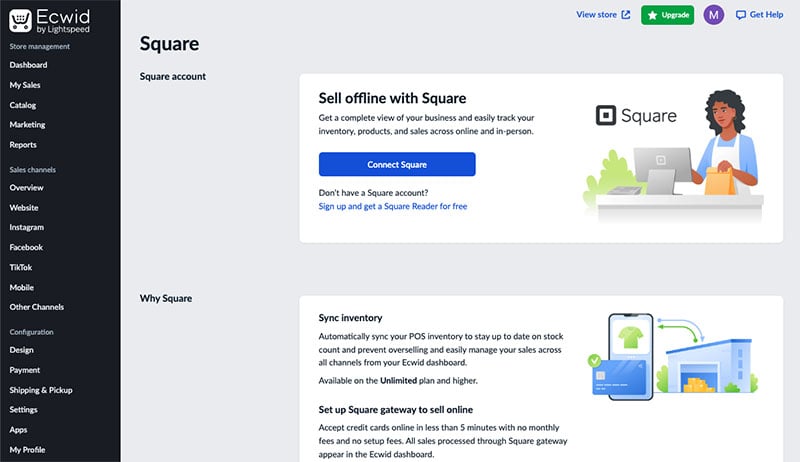
Shopify POS
With Shopify, POS is more ‘baked in’ and is therefore arguably a bit easier and cheaper to set up. You can order any POS hardware online directly from Shopify if you live in one of the following countries:
- Australia
- Belgium
- Canada
- Denmark
- Finland
- Germany
- Ireland
- Italy
- Netherlands
- New Zealand
- Singapore
- Spain
- United Kingdom
- United States.
If you live outside these countries you can still purchase this hardware, but will need to find an authorized reseller.
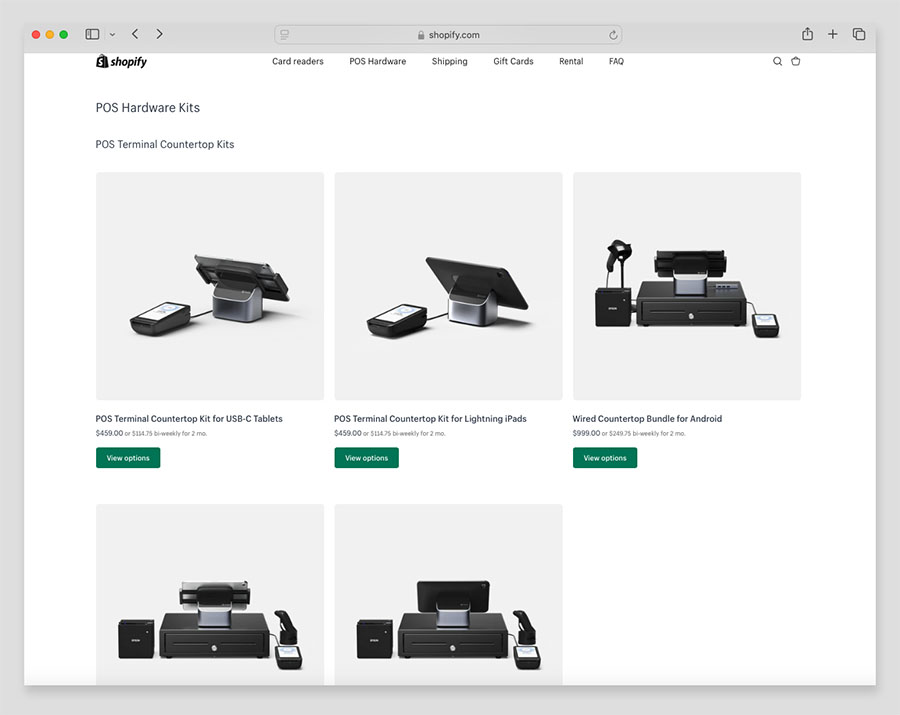
The standard Shopify POS features are reasonably good and will cater adequately for most merchants — but it’s worth noting that in order to unlock all the Shopify POS features, you have to pay for a ‘Shopify POS Pro’ add-on.
This is quite expensive: $89 per location, per month (unless you’re on a Shopify Plus plan, in which case ‘POS Pro’ is bundled with your subscription).
Paying for this add-on does unlock quite a wide range of POS features however, and lets you:
- work with an unlimited number of POS staff and registers
- facilitate ‘buy online, pick up in store’
- facilitate exchanges
- provide custom printed receipts
- define staff roles and permissions
- attribute sales to individual staff members
- access in-store analytics
- create purchase orders.
📚 Related resource: Shopify POS vs Square POS
Abandoned cart saving
Something worth paying particular attention to when it comes to ecommerce platform selection is abandoned cart recovery functionality.
This allows you to automatically email store visitors who added something to their cart but didn’t complete their purchase. (Typically, you’d include a discount code in this email to encourage recipients to go ahead with the purchase).
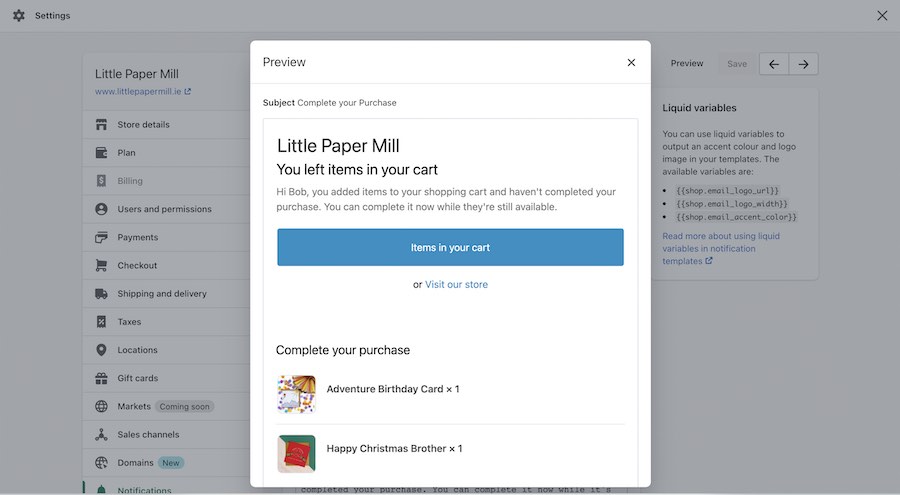
Abandoned cart recovery emails tend to have a success rate of around 15% to 28% — so this functionality is very important.
Both Shopify and Ecwid allow you to send abandoned cart recovery emails easily, but Shopify has an edge here. Its abandoned cart saver is more sophisticated than Ecwid’s, allowing you to send automated messages based on whether a user has:
- abandoned their cart during checkout
- left your store with items in their cart, but without starting checkout
- browsed products on your store, but not added them to a cart.
As you can see from the below screenshot from my testing of its abandoned cart saver tool, Shopify also lets you add conditions and actions to each step of the cart recovery process — this gives you the option to create an extremely ‘bespoke’ customer journey.

Ecwid doesn’t really offer this level of customization when it comes to abandoned cart recovery; additionally, while abandoned cart saving is available on any Shopify plan, Ecwid only offers it on its $55 ‘Business’ plan or higher.
So the winner in the abandoned cart saving department is definitely Shopify.
Multi-currency selling
You’ll generally get more online sales if you sell in the currency used by your store visitors.
And unlike some competing products — notably Wix and Squarespace — Shopify lets you do this out of the box (so long as you are using its built-in payment gateway, Shopify Payments). Using IP address data, Shopify shows your store visitors your product prices in their local currency, and lets them check out in it too.
Selling multiple currencies using Ecwid involves using an app — a popular choice being the appropriately named ‘Currency Converter’ app, which costs $4.49 per month.
The Currency Converter app makes it easy to display prices in up to 130 local currencies automatically — my only problem with it is that the store’s default currency gets displayed again at the final stage of the purchase, which may confuse buyers a bit. In other words, checkout doesn’t take place in a user’s own currency. That aside, this app works well.
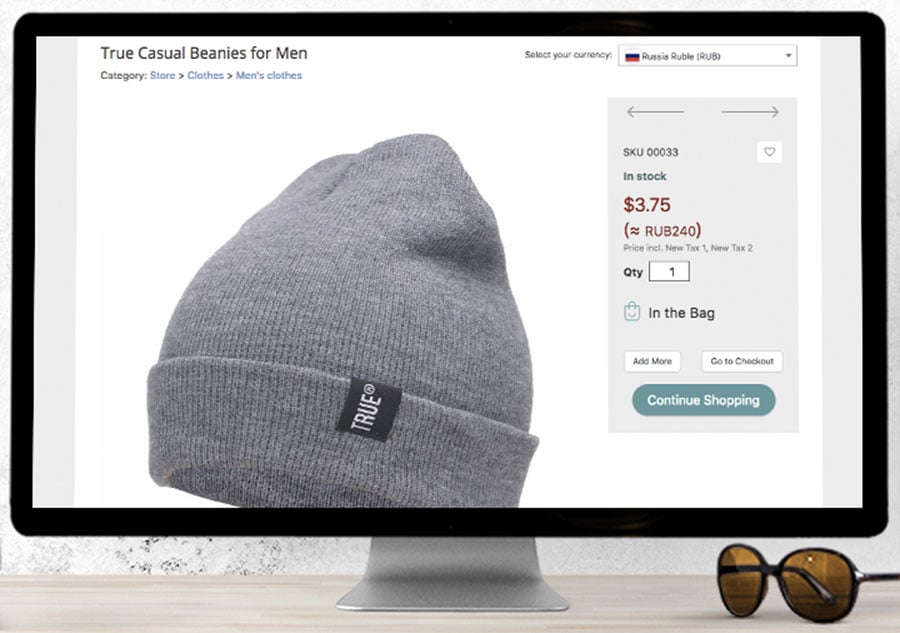
The bottom line on multi-currency selling with Shopify and Ecwid is that it’s doable with both platforms — but because the feature’s implementation is considerably better, Shopify wins here.
Selling products in different languages
Both Shopify and Ecwid facilicate multilingual selling.
In the case of Shopify, you can create versions of your store in up to 20 different languages on the ‘Basic’ or higher plans.
You do this via the ‘Shopify Markets’ feature, which lets you define selling areas — ‘markets’ based on country or groups of countries. You can then manage currencies, languages, local domains and payment processors for these markets all in one place.
(I’ve set up quite a few international Shopify stores using this feature, and have always found it particularly easy to use.)
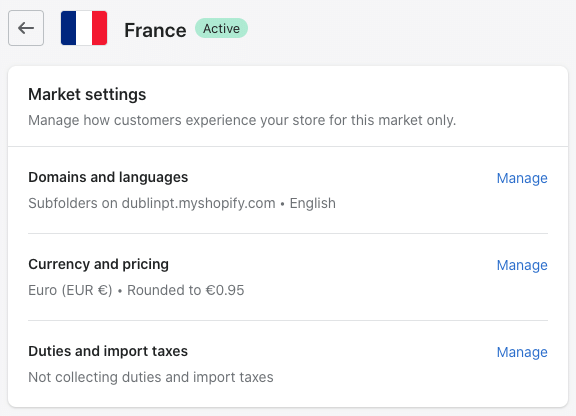
When you enable multi-language selling in Shopify, a language ‘folder’ is added to your domain — you’ll end up with myshop.com/fr, myshop.com/de etc. You can also use an ‘international domain’ — myshop.fr, myshop.de etc. — to host foreign-language versions of your store.
Ecwid’s multilingual features work in a different way — you can switch on an automatic translation feature, which functions in up to 36 languages (you can choose which ones to work with).
This automatically detects what language a user’s browser is working in and translates key components of your site — button text, social sharing tools and other important store labels — accordingly; for other components, like product descriptions, a manual translation will be required.
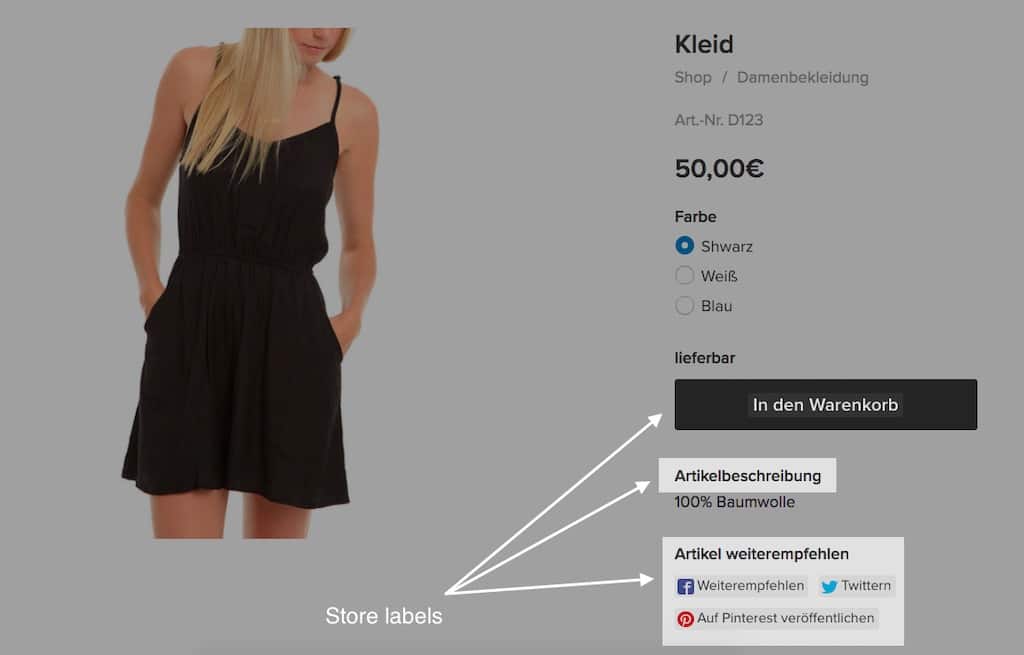
However, if you’re considering using Ecwid as part of a multilingual WordPress site, you should note that you’ll also need to install a dedicated language plugin like WPML or PolyLang to present your store in multiple languages.
Automatic tax calculation tools
Ecwid and Shopify are both ahead of the pack when it comes to tax rules and calculations — you can set both platforms up so that they detect your store visitors’ locations automatically and apply the relevant tax rate at checkout.
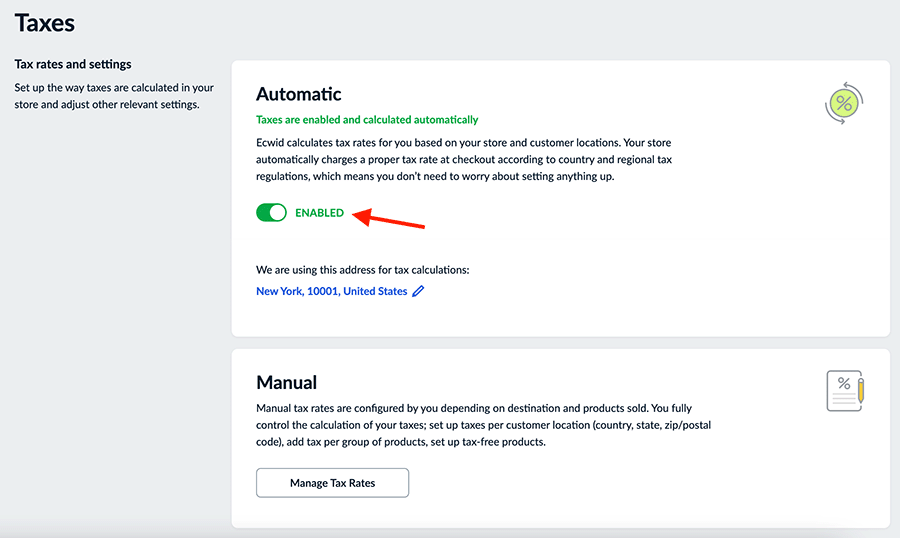
Significantly, neither Ecwid or Shopify restrict automatic tax calculation to US users — both platforms’ tax tools are designed to work in multiple territories (including the EU, UK, South Africa, Singapore and several other territories). This contrasts positively with several competing solutions, which tend to focus on the US only.
And helpfully, these tax calculations are applied not just to sales of physical products but digital ones too — meaning that both solutions cater adequately for the EU’s VAT MOSS requirements (again, something that can’t be said for many other online store builders).
Shipping options
Both Shopify and Ecwid give you a comprehensive set of shipping options — you can opt to add flat rates, free shipping, rates based on weight, in-person pickup etc.
When it comes to providing real-time rates from carriers to your customers, however, there are some differences to be aware of.
Ecwid has a built-in integration with the following carrier companies to automatically show their shipping rates for customers’ orders at checkout:
- UPS (US and Canada)
- USPS (US)
- FedEx (US)
- Canada Post (Canada)
- Royal Mail (UK)
- Australia Post (Australia)
A few more carriers (Sendle, DHL and Droppa) are supported via third-party apps.
Shopify provides real-time shipping rates for the following carriers:
- USPS (US)
- UPS (Canada and US, not available in Puerto Rico)
- DHL Express (US)
- FedEX by Shippo (US)
- Canada Post (Canada)
- DHL Paket (Germany)
- DPD (UK)
- Evri (UK)
- Chronopost (France)
- Collissimo (France)
- Mondial Relay (France)
- Purolator (Canada)
- BRT (Italy)
- Poste Italiane (Italy)
- Correos (Spain)
- SEUR (Spain)
- Sendle (Australia)
- Yodel (UK)
If you want to provide quotes from any other shipping carriers on a Shopify store, you’ll have to be prepared to pay extra to do so — this functionality is only available if:
- you are on the ‘Grow’ plan and happy to pay an additional monthly fee
- you have subscribed to an annual ‘Grow’ plan
- you’re on the $399 ‘Advanced Shopify’ plan or higher.
However, if you do live in one of the countries that Shopify provides built-in real-time carrier quotes for, you can avail of very significant discounts in shipping costs (depending on plan). These can go as high as 88% on the higher-tier plans.
Shipping discounts are also available from Ecwid, but only via USPS and only up to 50% in value.
The more generous discounts available from Shopify mean that depending on your country of operation, there may be an advantage using Shopify over Ecwid when it comes to real-time shipping quotes.
Embedding products on other sites with Ecwid and Shopify
As discussed above, Ecwid is, first and foremost, a tool for adding ecommerce features to an existing website; and by contrast, Shopify is more geared towards building brand new, fully-fledged ecommerce websites.
But with Shopify’s “Buy Buttons,” technically you can use Shopify to add a shopping cart to an existing website too.
(The Shopify ‘Starter’ plan is designed with this fairly exclusively in mind.)
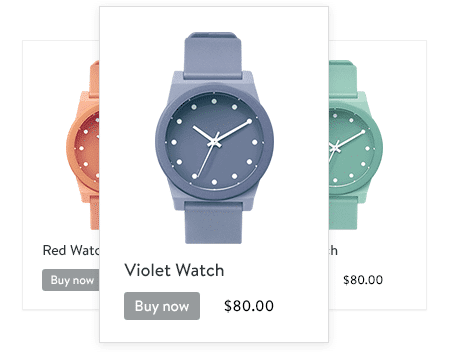
The difference between using a Shopify Buy Button and integrating Ecwid on your site is that with Ecwid, you get all the functionality of an online store — your site visitors can make use of product search, multi-currency selling, category filtering, product sorting and other key ecommerce features.
And everything happens on your site, including checkout, which makes for a smooth buying process.
You should note however that Shopify ‘Buy Buttons’ — although useful and easy to set up — only really let you display individual products or collections. When your customers check out, they’re taken to a separate Shopify checkout page.
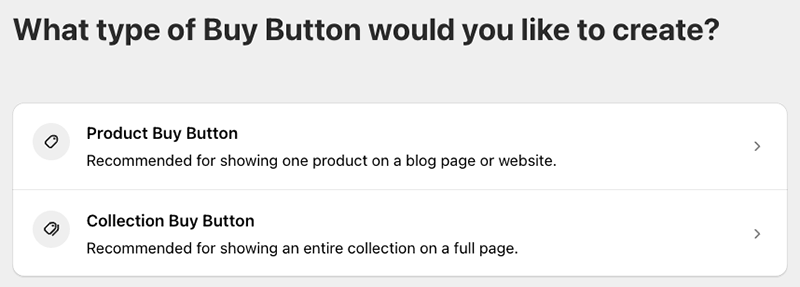
And Shopify Buy Buttons don’t facilitate multi-currency selling, which could be a big drawback for any merchants wishing to sell internationally.
So as things stand, I feel Ecwid is the more powerful tool for adding ecommerce to an existing site.
Creating standalone ecommerce stores in Shopify and Ecwid
While Ecwid is a better option for adding online selling features to an existing website, there’s no question that Shopify is the better option for users who want to build a brand new, fully-featured, standalone online store.
Its extensive range of templates (24 free and 864 paid-for), intuitive content management system, blogging features and extensive app store all allow you to create not just a storefront but a professional, multi-page website.
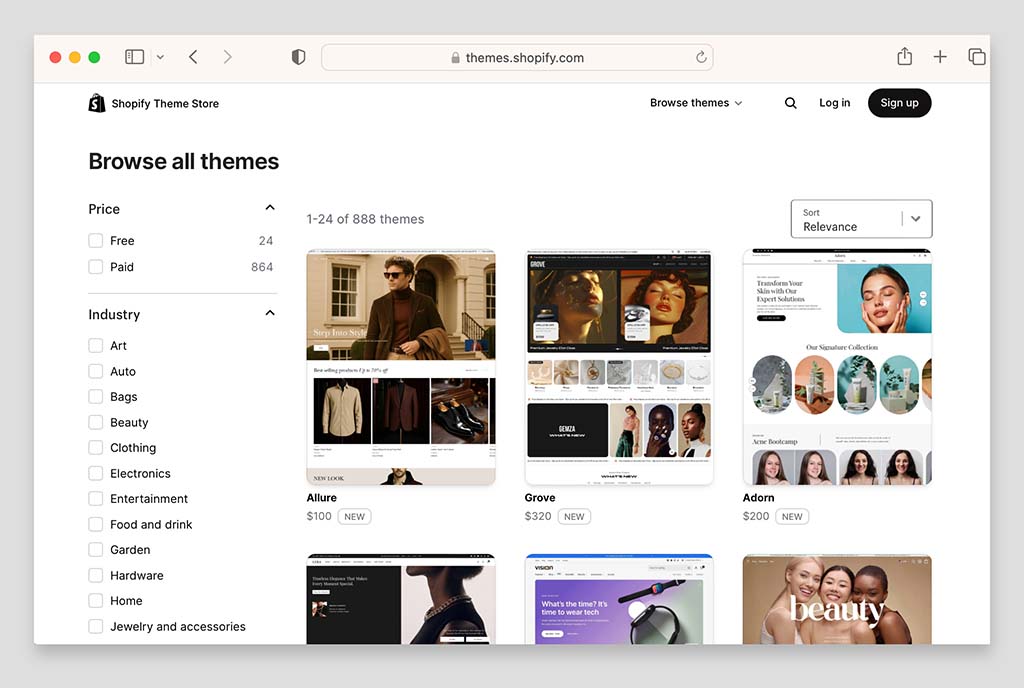
While Ecwid does now boast a feature — ‘Instant Site’ — that lets you build a standalone store, when I built test stores with this I found it to be a fairly basic offering. For a start, it only lets users create 1, 3, 10 and 100 pages on Ecwid’s ‘Starter,’ ‘Venture,’ ‘Business’ and ‘Unlimited’ plans respectively.
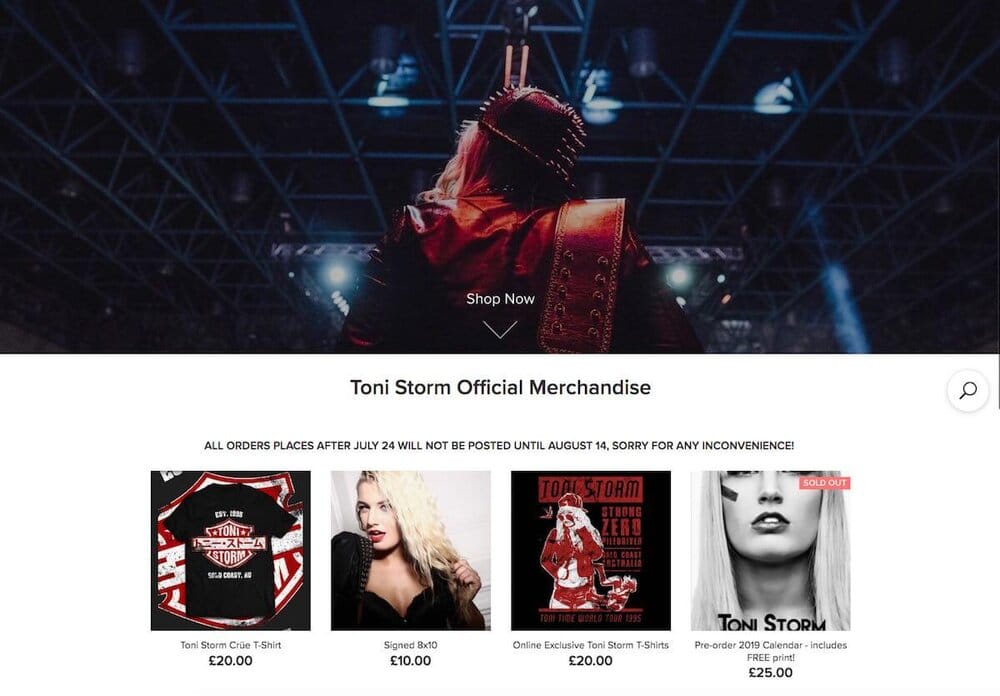
The main advantage of Ecwid’s ‘Instant Site’ tool is that it allows a beginner to put something together and sell products really quickly — while testing the feature, I managed to build a fully-functional site with it in about twenty minutes.
It’s also a very useful tool for creating a holding site or landing page during the build of a more comprehensive online store.
Additionally, the range of themes on offer for an Instant Site is generous: you can choose from 79 Ecwid templates.
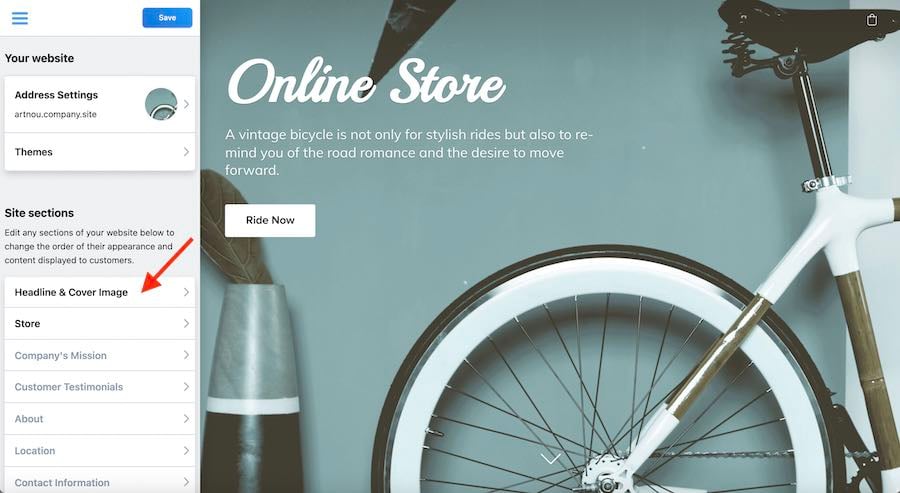
But ultimately it’s not going to remotely compete with Shopify when it comes to functionality.
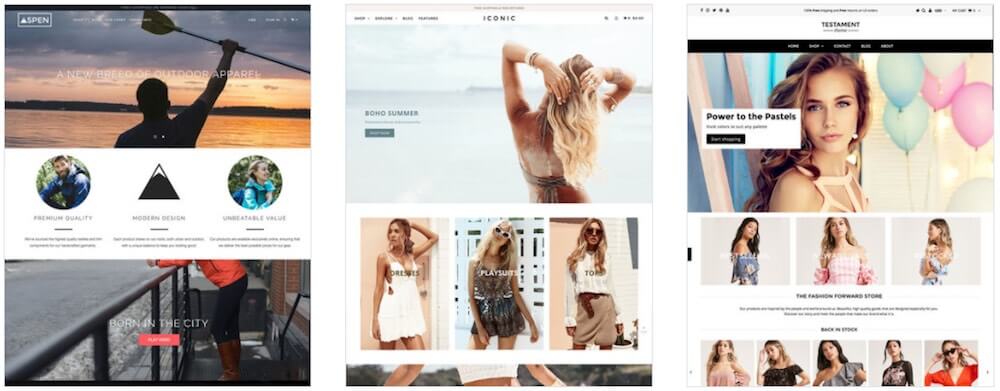
So, if your main aim is to build a standalone online store, the better product of the two is definitely Shopify.
Integrations and apps
If you’d like to beef up the functionality of an Ecwid or Shopify store, or integrate another tool with either platform, you can make use of their respective app stores.
These contain a selection of apps that add particular pieces of functionality (dropshipping, reporting, popups etc.) along with integrations with other key business apps and services. A mixture of paid-for and free apps is available.
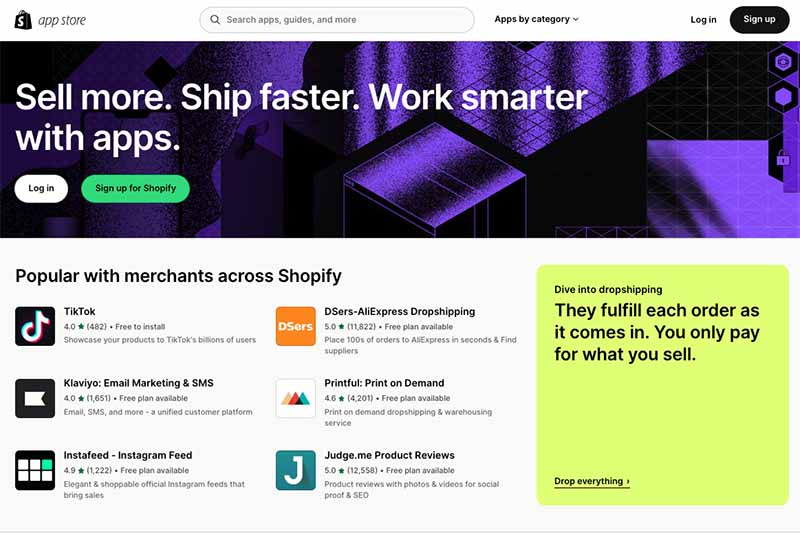
In the case of Ecwid however, you’re dealing with quite a limited selection of apps — I only found 411 of them in its ‘app market’, a number that is completely dwarfed by the 16,000+ available for Shopify.
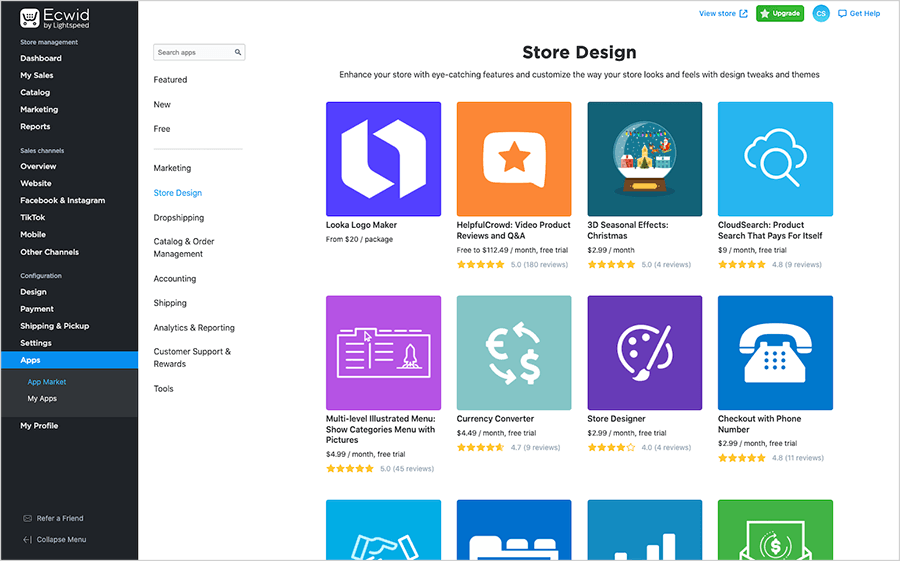
This means that although integrations for some pretty important apps like Freshbooks, Shipstation and Printful exist for Ecwid, you’ll generally find it easier to integrate Shopify with a wider range of well-known apps.
(The other thing to bear in mind is that you can’t connect apps to Ecwid if you’re on its ‘Starter’ plan.)
Although the range of integrations for Ecwid is relatively small by comparison to Shopify’s, you should note that it’s possible to use Zapier to connect additional services to Ecwid. This is a popular ‘syncing app’ that allows you to create your own customized integrations between a wide range of online apps.
The problem here is that Zapier brings a set of additional fees to proceedings — and based on my experience of hooking it up to other apps, you’ll need to be prepared to encounter a fair bit of configuration and testing time.
So overall, because its app store is better stocked and brings a greater degree of flexibility when it comes to integrating other tools with your online store, the winner when it comes to apps and integrations is definitely Shopify.
SEO features in Ecwid and Shopify
Search engine optimization in Shopify is generally very strong: it’s easy to tweak all the major SEO components — headings, page titles, URLs, meta data and so on.
(Tip: if you’re new to SEO and confused by the above terms, you’ll find explanations of all of them in our introduction to increasing site visibility in search results).
Although Ecwid performs reasonably well on all these fronts too (so long as you’re on a paid plan), it’s worth singling out some areas where Shopify outperforms Ecwid in SEO terms: URL creation and meeting Core Web Vitals requirements.
URL creation
In terms of URL creation, you can create clean URLs easily with Shopify (a practice that Google recommends). You can also change these URLs as you please — and create a redirect from old URLs to new ones (this is important for keeping your content and products indexed properly in search engines).
You can also create short, SEO-friendly URLs using Ecwid and if you’re on a ‘Business’ or ‘Unlimited’ plan, change them too. But if you’re using the widget version of the platform (rather than the ‘Instant site’ one), there doesn’t seem to be an easy way to create redirects from old URLs to new ones. I don’t think this is ideal, really.
Core Web Vitals in Ecwid and Shopify
Core Web Vitals are a set of targets relating to the speed, responsiveness and visual stability of a website; and sites that meet them can sometimes receive a slight improvement in performance in Google search results.
Shopify enjoys a bit of an edge over Ecwid here, because tools are available (in the form of third-party apps and built-in reports) to help you tweak your store in ways that will help you meet Core Web Vitals standards.
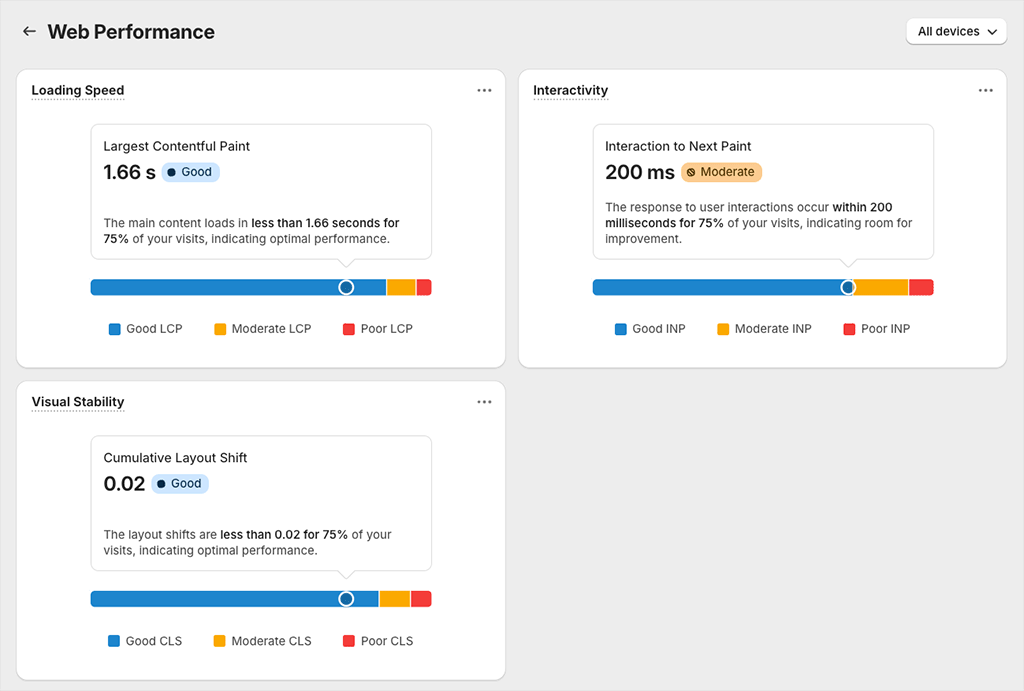
With Ecwid, you may have to take more manual steps — including possibly some coding — to ensure that you’re following best practice as far as Core Web Vitals goes.
So the bottom line on SEO? Well, although it is possible to optimize an Ecwid store successfully for search engines, it’s hard not to conclude that the better option on this front is Shopify.
Staff accounts
If you want to let a lot of users access either an Ecwid or a Shopify account, you’ll need to be aware that tighter limits apply to the number of ‘seats’ you can have on Shopify.
On the ‘Basic’ Shopify plan, 1 user can access your account; on the ‘Grow’ plan the limit is 5; and on the ‘Advanced Shopify’ plan it’s 15.
I find Shopify’s one-user limit on its ‘Basic’ plan particularly ungenerous — it makes the entry level plan unsuitable for any business requiring multi-user access (even small businesses with only two or three staff members).
By contrast, Ecwid lets you have an unlimited number of seats on its ‘Unlimited’ plan, which may suit some merchants better (the seat limit for the other plans is 1 on the ‘Starter’ and ‘Venture’ plans and 2 users on the ‘Business’ ones — so it’s a bit of a could-do-better for Ecwid here, too).
Interface and ease of use
Ecwid and Shopify have pretty similar content management systems: you use a main menu on the left which you use to access all the main features.
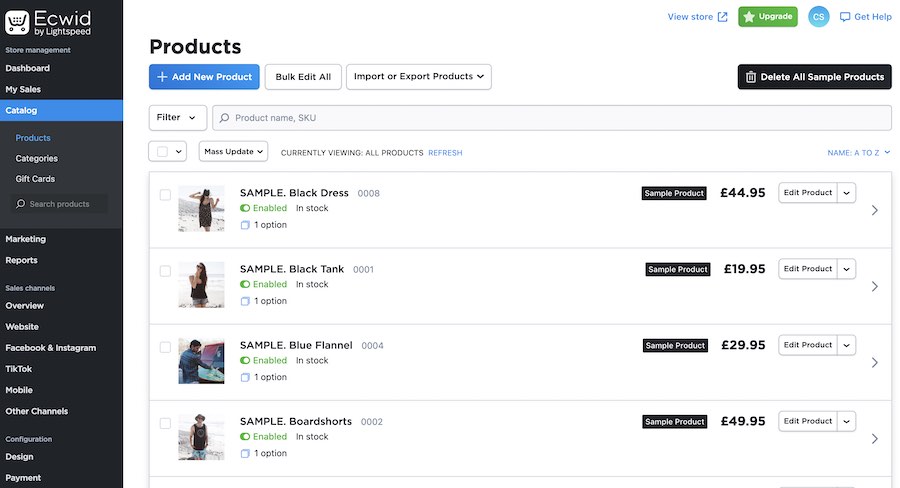
Any product uploading or management is done on the right hand side of the interface.
One area where Ecwid’s CMS definitely outperforms Shopify’s involves image management — in Shopify, you have to ensure that all your products share the aspect same ratio before uploading (not doing this makes for a very messy looking store). This can mean a lot of photo editing in Photoshop before you can upload all your products.
Ecwid simply allows you to apply an image ratio globally to all your product pictures — a huge time saver.
Additionally, both platforms provide you with mobile apps (for both iOS and Android) that allow you to perform key tasks on the go; you can use these apps to handle order fulfilment, inventory management, customer support etc.
The main Shopify and Ecwid apps have both been well received by iOS users, scoring 4.7 and 4.6 out of 5 on the Apple store respectively. The Android version of the Ecwid app beats the Shopify equivalent slightly — it’s rated 4.4 out of 5 while Shopify scores 4.2.
Overall, I’d say that both platforms are easy to use and anyone with modest experience of computing shouldn’t expect too much of a learning curve from either.
Related resource: Guide to starting a Shopify store
Reporting in Shopify vs Ecwid
Basic sales stats are available in Ecwid out of the box (visitors, orders received, total revenue etc.), but to get more detailed information on how your store is performing you’ll need to install a third-party reporting app. Several are available, but not all of these are free.
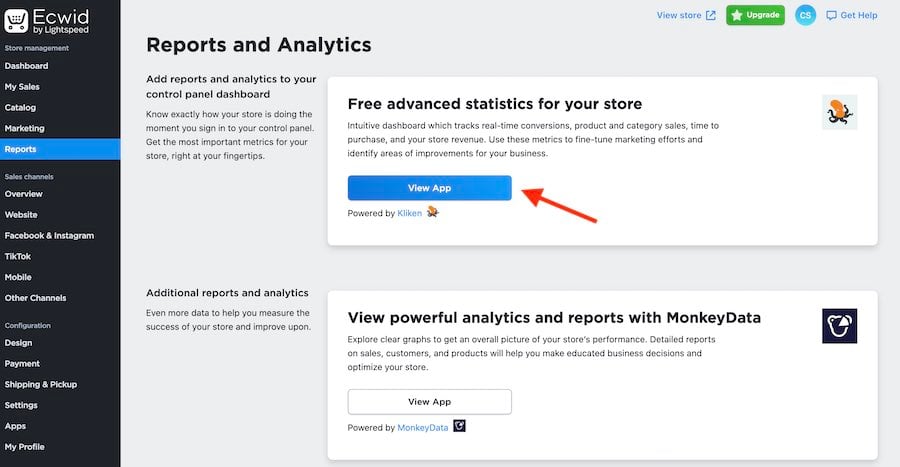
Shopify provides a much more comprehensive range of reports ‘out of the box’ — I counted 90 separate reports while testing its reporting features. Key ones you can pull include:
- sales reports
- customer reports
- marketing reports
- search data reports
- finance reports
- abandoned cart reports.
You just go to the ‘Analytics’ section of your Shopify control panel to view them.
The other option with both Ecwid and Shopify is to use Google Analytics to track traffic, behaviour and sales — but you will need to spend a bit of time configuring this.
Customer support
When it comes to the type of support channels you can access, Ecwid lets you access its customer service team via live chat, email and phone. However, you should note that support on its ‘Starter’ plan is provided via email only, and phone support is only available on its $55 per month ‘Business’ plan or higher.
Most Shopify subscribers will only ever be able to access live chat support, because phone support is only provided to users on a $2,300+ ‘Shopify Plus’ plan.
(And using Shopify’s live chat service entails addressing your query to an AI chatbot first. My experience of this was better than you might think — it did answer quite a lot of my queries accurately. But many users will find this hoop you have to go through before talking to a human annoying.)
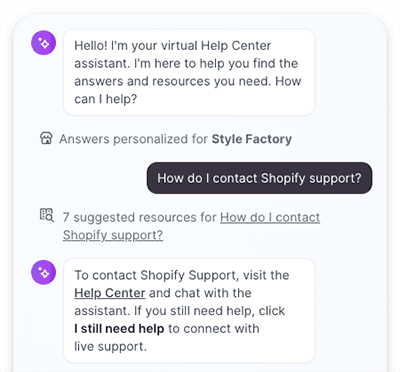
On the plus side, Shopify support is available in more languages than Ecwid — 18 languages are catered for, which compares positively to Ecwid’s seven.
But Ecwid gives you something on the support front that Shopify absolutely doesn’t: ‘customization hours.’ If you subscribe to an Ecwid ‘Business’ or ‘Unlimited’ plan, you can avail of two or six hours of personalized support respectively.
I’d argue that this, combined with the easier access to phone support, means that Ecwid has the edge in the support department.
Ecwid vs Shopify: user reviews
You’ve heard my thoughts on Ecwid and Shopify — but to give you a broader sense of how each platform is received, I’ve included user ratings from leading software review sites below (figures correct as of August 2025).
| Site | Ecwid user rating | Shopify user rating |
| Capterra | 4.6/5 (585 reviews) | 4.5/5 (6,599 reviews) |
| G2 | 4.7/5 (401 reviews) | 4.4/5 (4,690 reviews) |
| GetApp | 4.6/5 (585 reviews) | 4.5/5 (6,600 reviews) |
| TrustRadius | 10/10 (20 reviews) | 8.9/10 (653 reviews) |
| Average user score (out of 5) | 4.73 out of 5 | 4.46 out of 5 |
As you can see, Ecwid narrowly comes out on top, with an average user rating of 4.73 out of 5, compared to 4.46 for Shopify. That said, Shopify’s scores are based on a far larger volume of feedback — more than 18,500 reviews across the platforms surveyed — which suggests a broader user base and more varied experiences.
Ecwid vs Shopify conclusion
Ultimately, if you’re a small business that’s building an ecommerce site from scratch, then it’s hard to argue against Shopify — a user-friendly product that will let you build an elegant standalone online store easily. Although Ecwid, thanks to its ‘Instant Site’ feature, does now provide you with a way to build a standalone site too, the functionality provided by it is nowhere near as comprehensive as what you’ll get from Shopify.
However, if you already have a website, or are particularly wedded to using a particular platform, then Ecwid can be the more obvious choice. It allows you to add full selling capabilities to an existing online presence with a minimum of fuss, and provides you with all the tools you need to turn any website into an online store.
(In particular, Ecwid is a particularly good fit for Wix or WordPress users, as it integrates very neatly with both platforms).
Shopify ‘Buy Buttons,’ while allowing you to do some simple selling on existing websites, don’t really provide the full online store experience or features that Ecwid can bring to a website that’s already live.
As ever though I do recommend trying products out to discover which platform feels like the better fit for your product.
I’ll sum up with a few more reasons why you might pick one of these tools over the other — and do feel free to leave your own thoughts about these platforms in the comments section.
Shopify vs Ecwid: pros and cons summary
Reasons I’d choose Ecwid over Shopify
- Ecwid allows you to turn any existing website into a fully-featured online store — Shopify’s Buy Buttons, while useful, don’t bring quite as much functionality to the table.
- There are no charges for using a third-party payment gateway (Shopify will charge transaction fees if you don’t use its built-in payment gateway).
- There are no limits on product options (Shopify only facilitates 3 out of the box).
- Ecwid makes capturing bespoke information easier (text for engravings, files for images etc.).
- Selling digital files is easier with Ecwid and the file size limit is more generous (25GB to Shopify’s 5GB).
- Product image management is easier in Ecwid.
- Thanks to more integrations with more carriers (in more countries), there are more options available when it comes to real-time carrier shipping quotes.
- You can create GDPR-compliant cookie banners out of the box with Ecwid.
- Ecwid gives you access to more customer support channels.
Reasons I’d choose Shopify over Ecwid
- You can create a fully-fledged, sophisticated standalone online store with Shopify.
- You can host an unlimited number of products on any Shopify plan.
- A larger selection of payment gateways is available for Shopify — this gives you more ways to accept payments.
- Point-of-sale is more tightly integrated with Shopify than with Ecwid — you don’t need to integrate a third-party platform or be on a higher-tier plan to gain POS features.
- Abandoned cart saving functionality is available more cheaply from Shopify.
- There are more dropshipping options available for Shopify than Ecwid.
- There are more print on demand options available for Shopify than Ecwid.
- Shopify multi-currency selling options are more comprehensive and importantly let store visitors check out in their own currency.
- There are considerably more apps and integrations available for Shopify than Ecwid.
- So long as you’re based in the right country, and happy to use one of Shopify’s preferred carriers, you can avail of some very significant reductions in shipping costs with Shopify.
- The SEO tools and features in Shopify are stronger.
- Shopify customer support is available in more languages than Ecwid’s.
- There’s a proper free trial available for Shopify.
Alternatives to Ecwid and Shopify
If you’re looking for a hosted solution for your online store, I’d recommend BigCommerce as a good alternative to Shopify. You can read my BigCommerce review here.
Other good hosted solutions for ecommerce include Squarespace, Big Cartel, GoDaddy and Wix.
See our Squarespace review, Squarespace pricing guide, Squarespace free trial guide and Wix review for more information on these website builders.
Our Wix vs Squarespace and Squarespace vs WordPress comparisons may help here too.
If you are running a WordPress site and want a store that ‘slots into’ your site in a similar fashion to Ecwid, then WooCommerce is definitely worth a look.
Finally, you could consider using an online marketplace like Etsy, eBay or Amazon to sell online.
Although these platforms work in quite different ways to hosted solutions like Ecwid and Shopify, you can nonetheless get a successful online store off the ground with them.
If you’re interested in finding out more about selling this way, our Shopify vs Etsy, Shopify vs eBay and Amazon vs Shopify comparisons are good starting points.
Ecwid vs Shopify FAQ
Are Shopify and Ecwid good for beginners?
Yes. Shopify and Ecwid are designed for a ‘non-coding’ audience, so both are pretty easy for ecommerce and web design novices to use.
Can I use Shopify and Ecwid for free?
A free trial is available for Shopify, but not for Ecwid. Ecwid used to have an entirely free plan, but this has been recently discontinued.
Which is better for SEO, Shopify or Ecwid?
On balance Shopify is the better bet for SEO. It gives you more control over SEO components and lets you create and change SEO-friendly URLs more easily.
Can I build a standalone store with Ecwid?
Yes — its ‘Instant Site’ feature lets you do this. However, the features it provides do not yet compete with Shopify’s offering on this front.
How we tested these products — and why you can trust this comparison
We tested these products via independent research and, more importantly, via hands-on experience of them.
We regularly help clients build online stores using a variety of different platforms and have extensive knowledge of how both Ecwid and Shopify work. So this comparison is based on building many stores from scratch; editing existing ones; and using a wide variety of apps to configure them.
Although our work is supported by affiliate advertising commissions, we believe in an ethical approach to product reviews and strive to be 100% impartial at all times.
Related Shopify and Ecwid content
For more information about Shopify and Ecwid, check out:
- our full Shopify review
- our full Ecwid review
- our Shopify video review
- our Wix vs Shopify comparison
Update details
This article was updated on 1 August 2025. The following edits were made:
- User statistics for both platforms were updated.
- A new screenshot of the Shopify Theme Store was added
- Template and app store data was updated.
- A ‘user reviews’ section was added.
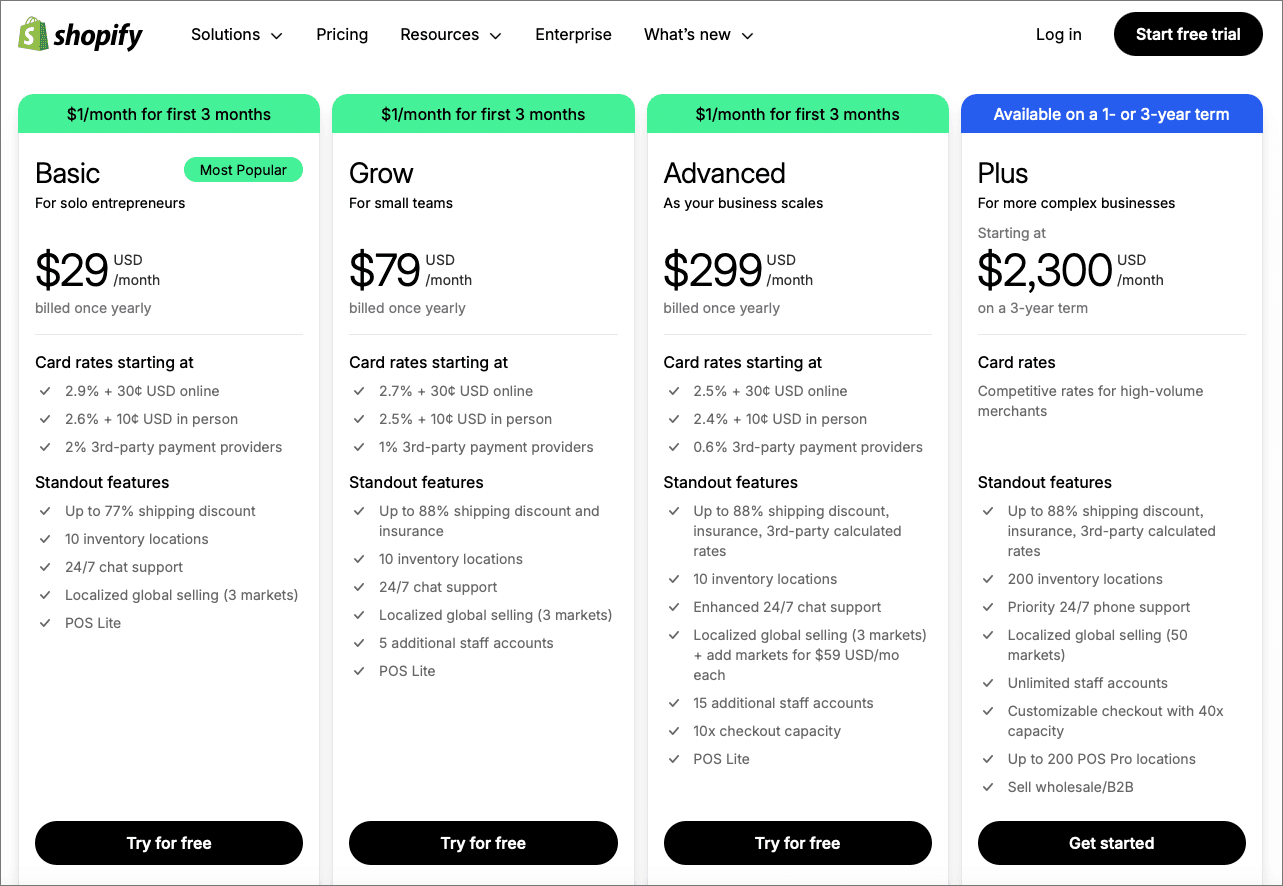
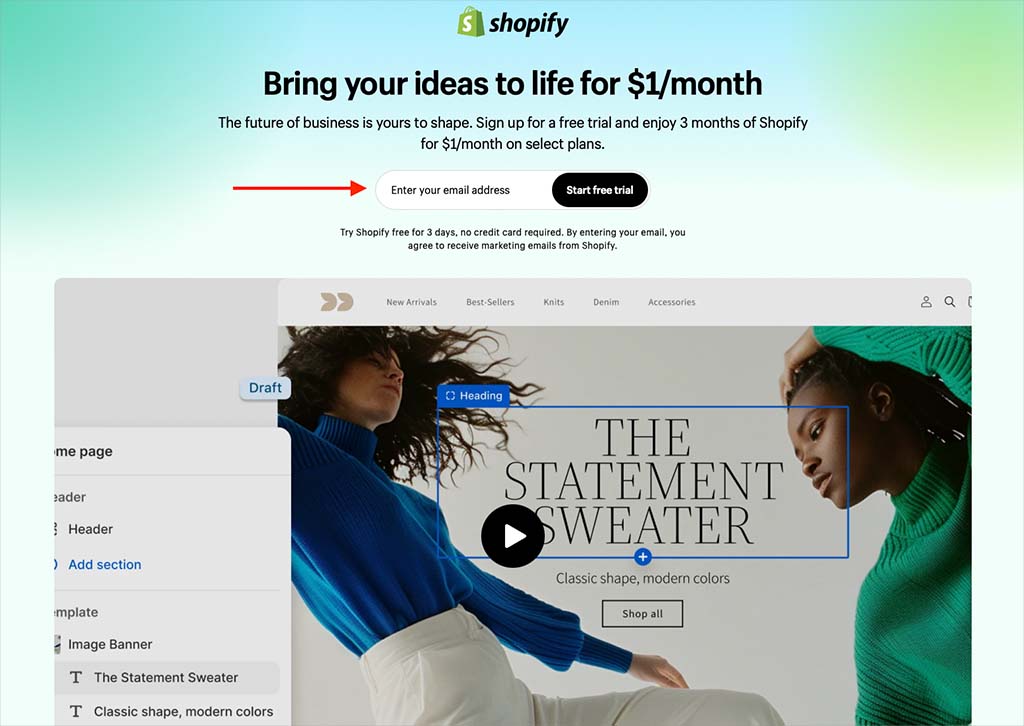
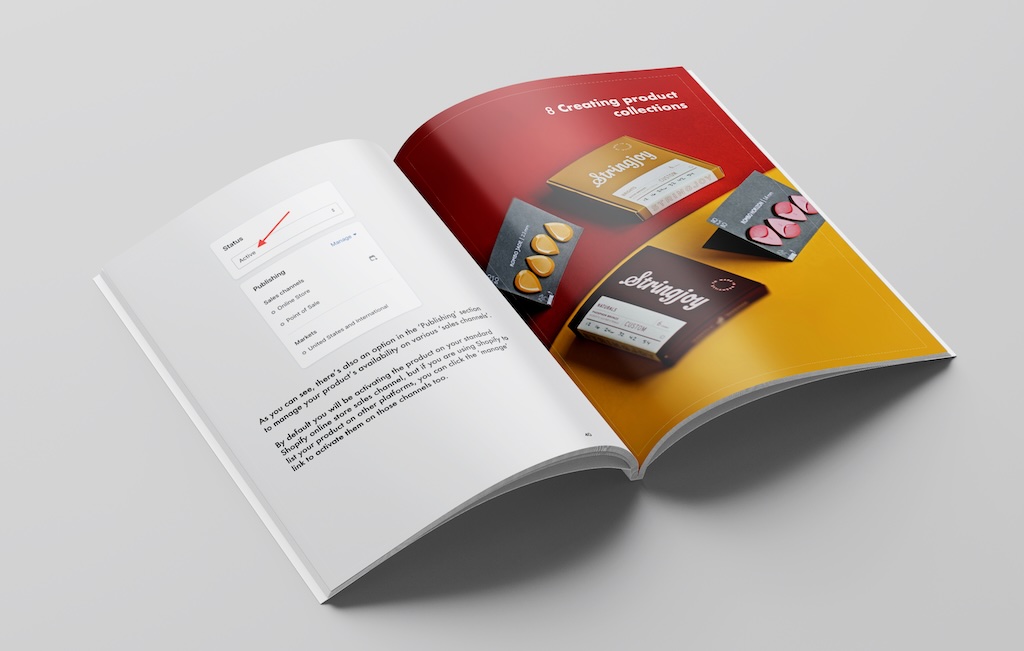

Comments (25)
Thanks Chris, incredibly helpful
No worries Mike – I’m glad the comparison was of use 🙂
Really good article, thank you for explaining pros and cons! I’m starting my small online business and decided to give it a go with Ecwid because it really seems it could work for me after reading ur article! Many thanks!
No problems Ananda, I’m glad you found our Ecwid vs Shopify comparison useful 🙂
Great article, great website. I’m just getting started and am looking to use the Ecwid instant site with one page – will I be able to sell the 10 products we have on our Facebook page, and will we be able to run Facebook ads that would lead customers to our Ecwid page or Facebook page?
Thanks for the kind words Eric! Depending on what you’re selling, you shouldn’t have any problems doing this – full details about the Ecwid and Facebook integration are here: https://support.ecwid.com/hc/en-us/articles/115005892705-Selling-on-Facebook
Hope this helps, Chris
How to integrate Ecwid to existing website? I use Google sites and iframe to do the integration. It sucks when it comes to customer registration. The Ecwid brings the customer to a blank page instead of the customer account page. Customer service of Ecwid said there is no solution to this issue. How about integration for other website?
Immensely helpful article. Thanks so much for taking the pain out of comparing these two options and for the thorough analysis of each one.
Thanks for the feedback Jihaan, thanks for reading and I’m glad you found the comparison useful 🙂
Very interesting and complete analysis. Helped a lot!! Thanks!!! Carlos
Thank you, this is super helpful. I’m wondering if you’re familiar with using Clover POS with either Shopify or Ecwid. My client needs a new website with a few pages in addition to an online store of around 400 products. We want to be able to migrate the inventory from Clover to the online store, BUT still have some ability to control the design. Do recommend on over the other? And, for Shopify do you know the best way to integrate with Clover?
Hi Nancy, many thanks for the kind words!
There is an official integration for Clover with Ecwid – details here:
https://support.ecwid.com/hc/en-us/articles/207102159-Ecwid-for-Clover-POS
Shopify POS is more of an ‘out of the box’ affair, so there’s less of an emphasis on integrations with other POS systems. That said, they do exist — I found one syncing tool which might help here:
https://www.skuiq.com/shopify-clover-integration/
With regard to store design, your options are more extensive really with Shopify than Ecwid, because Shopify is a template driven system and there are lots available for it. Ecwid is more about slotting into a website that’s already been built and making use of that site’s existing design.
Lots of detail in your comparison! Inventory management is an interesting thing and I have yet to read any blog that touches on this very basic inventory need; the ability to run an inventory report. Ecwid cannot currently provide any data on stock levels if you use options and variations. It’s a very old complaint based on Ecwid support forum posts going back to 2013 and it remains an issue. It’s very difficult to manage inventory when you don’t know what you have in stock or what you need to replenish.
This was a really informative blog post – thank you! Would love to see something comparing ecwid and plugnpaid 🙂
Thanks Leann – we’ll try to get around to a comparison of those two products at some point!
ECWID is already having AMP pages, Check out this https://www.ecwid.com/blog/dont-panic-its-dynamic-how-amp-emails-are-changing-e-commerce.htmlI hope I am correct?
Hi there, Ecwid provides AMP for email functionality, which is useful but different. It allows you to send ‘dynamic’ notification emails which automatically update themselves based on an external data source.
They also let you display dynamic content within an email. For example, with Ecwid’s dynamic abandoned cart emails, customers can click through the product carousel, zoom product images, and open product descriptions right without leaving their email program or visiting a website.
Shopify integrates with more payment gateways, but since they’re after the processing revenues as well, Shopify charges an extra percentage on top of the processing fees charged via the merchant account for the gateway. It’s a feature that’s not really a benefit, since Shopify basically prices you to where you’d have to use their processing.
I am a geek so I tend to focus on the technical features. One thing that the review has not touched on is the quality of the APIs. Every marketplace has an API that allows you to automate your drop-shipping. So, for example, automatically adding new products, updating stock levels, pricing, etc. APIs also allow you to synchronize orders back to a drop-shipper.
The more complex the API, the more difficult it is to integrate. Shopify is very clean and well documented. There are a lot of generic plugins and other apps that are built on it. But one thing I found is that it is very bad at batch updates. Let’s say you have 10,000 products to update. With Shopify you have to update them one at a time. To compound that they impose a 2 request/s limit. So it will take almost two hours to complete. BigCommerce has a better way to do this but then you have other tradeoffs.
I talk about drop-shipping automation on my YouTube channel if you want to learn more (warning, lots of geeky stuff 🙂 https://www.youtube.com/channel/UCYyNQkBavu0x19SWIyl8uSA
Who wants to buy apps if you’re already paying for Shopify? Also, you missed the fact that with Ecwid you can also list on eBay, Google Shopping, Shopzilla etc under the $35 monthly business plan which we got for $20 a month prepaid as a special offer, total no brainer and it seamlessly connected to our site as well as eBay and is so simple to use and looks super professional. Shopify is great for the person who needs to get a tee shirt shop (or the like) up there from scratch but we have a pro site established with traffic so Ecwid rocks!
By mnmca, May 26, 2016 for WP 4.5.2I pay for an ECWID shopping basket and it works well but for the second time my traffic has gone to NIL. Nobody from their team can figure it out. I was told to use wordpress (I run that on mnm.ca/m) and with their plugin the seo is supposed to be automatic. It works great until one day nothing. For the second time all google listings disappear and nothing but error pages show up on the google console. So if you rely on a search engine to get traffic to your site I would advise you to stay away from an ajax shopping basket. The seo is just a nightmare, google still does not properly crawl ajax and relying on the ecwid plugin can cost you big time in losses.
I’m using Ecwid for one year already. I started with the free plan which I believe is among the only e-stores of the internet to offer so much features for free, even if that’s 10 products max. Since I had already a website built in html, I just had to copy paste the code and voila. You can’t imagine what a relief it is to have so simple setup for payment gateways (paypal, stripe even local ones here in europe), to add the products and also have really nice email notifications and so.
Few days ago I switched to the payed plan for 15/month just to have the coupon codes but otherwise is more than enough even with the 10 products, specially for startups who launch 1-2 products, because you have a ready to go shop with 0 expences if you already have the website. Now tell me where do you get that with Shopify or WooCommerce, where only the Paypal and Stripe plugins are costing you few hundred dollars, not to mention extra languages, customisation… pain in the ass believe me. And when you move your store or renew your website to a wordpress for example, you don’t have to worry about losing databases, re-uploading products and all that crap. Again, just copy paste the block of code and you have the store. I can imagine for big shops with hundreds or thousands of products might be a better investment Shopify, Magento or WooCommerce, but for beginners I can’t recommend something better and cheaper than this. The downside might be that you have to change a bit the css for having customised the buttons, colors and so on, but there’s already some apps that can simply change that visually and you just copy the theme code in the shop administration page.
I believe they will improve a lot, as during one year since I use it they’ve modernised the interface, the invoicing system, email notifications, taxes managing even in Europe for the VAT changes they had lately, multi-language , integration with MailChimp… and many more. If they would handle more shipping providers here in Europe would be great like DPD which is cheap and reliable but can imagine is a lot of logistical work and takes time.
And somebody here was complaining about support, I can’t really argue about that, but so far I haven’t had issues. Even on the forum they were answering to all questions.
I believe in few years they’ll be among the big players in this market due to the flexibility of the store concept and price.
thanks
Ecwid -I have tried it and it is the WORST! Horrible customer service, bad features and BS..I would not even want their service #ecwidworst #ecwiddonotbother
This is helping me so much, thanks!